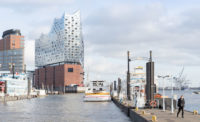CaixaForum by Herzog & de Meuron
Madrid
Few protected historic structures have been treated with less respect than Madrid’s Central Eléctrica de Mediodía in its transformation into the CaixaForum cultural center. But given the limited architectural value of the power plant, built in 1900, and the brilliant irreverence of the intervention, this is a deed that can only be celebrated. In what they describe as a surgical operation, Swiss architects Jacques Herzog and Pierre de Meuron demolished the original roof and interiors. They cut away the granite base of the brick exterior walls, creating the illusion that the building floats in midair, hovering over a covered entry plaza. With the addition of two upper stories clad in rusted cast iron and two underground levels, they doubled the building’s height and increased its size five times to more than 100,000 square feet. In short, the architects have skinned and gutted the structure like an animal, transforming its tattered brick shell, four withes thick, into an exotic, pelt-like veneer. This metamorphosis has been carefully pulled off, but it is also smart, mischievous, and energizing fun.
CaixaForum Madrid is owned and operated by the Social Works Foundation of La Caixa, Spain’s largest savings bank, and is dedicated to programs in art, music, theater, and literature. The generating station occupying the site the foundation chose had won limited protection for its role in the early electrification of Madrid, but the local Heritage Commission approved its partial demolition based on the project’s merits and public benefits. Located amid narrow streets not far from the Prado Museum, the building was cut off from the nearby avenue of the Paseo del Prado by a gas station that Herzog and de Meuron convinced the client to buy and demolish. This acquisition allowed them to enlarge the entry plaza and establish a connection to the Paseo, Madrid’s Museum Mile, which is soon to be refurbished by Alvaro Siza. The CaixaForum joins Paseo cultural institutions such as Rafael Moneo’s 1992 Thyssen-Bornemisza Museum and his recent expansion of the Prado [record, March 2008, page 118]. Also nearby is Jean Nouvel’s Reina Sofía Museum addition [RECORD, July 2006, page 84].
The basic strategy of the CaixaForum design is similar to that of Herzog & de Meuron’s 2004 Barcelona Forum [RECORD, June 2004, page 109]. In both cases, the architects lift the buildings off the ground to create a shaded public plaza and point of entry, with essentially windowless program spaces above. In Madrid, these spaces include a first-floor lobby, two levels of exhibition galleries, and an attic café, with below-ground classrooms and an auditorium. The scheme is a variation on the classic Corbusian use of pilotis. But here the architects conceal the means of support (viewed from outside, the three cores seem to disappear behind signage and mirror glass), creating a sense of tension by posing the suspended mass of a masonry building just over visitors’ heads.
This spatial compression is accentuated by the irregular site conditions, with the narrow back streets sloping upward on one side, while the careful positioning of the cores subtly guides visitors along a diagonal toward the entry stair. As in Barcelona, the architects skillfully handle the reflective surface of the plaza ceiling, the lighting, and the sound of water from a pool, to create a cool, grottolike space of shadows and reflections.

